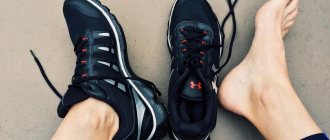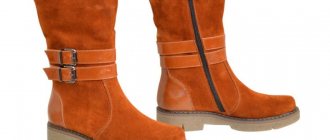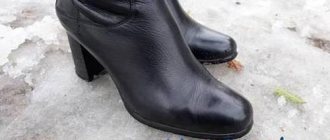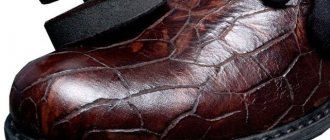New shoes are pleasant to wear, they please the eye and give you self-confidence. But if the beloved couple presses or rubs, it turns into an instrument of torture. The simplest solution in this case is to contact a specialist. However, there are many reliable ways to stretch shoes at home without spoiling their appearance. The main thing is to take into account the type of material used: what is good for leather is completely inapplicable to suede. Once the most suitable option for stretching has been selected, you can safely get to work, because putting up with discomfort is not only difficult, but also dangerous to your health.
Basic methods
There are different ways to stretch shoes at home. If used correctly, the boots will become a little larger without losing their appearance and quality.
Mechanical
At a shoe repair shop or specialty store, you can purchase special wooden or plastic shoe stretchers that are adjustable with screws. They will widen narrow shoes or boots by 2-4 mm, and increase the length by one size if necessary. The kit includes small rubberized inserts that allow you to influence specific areas. This makes life much easier for people with non-standard feet, such as hallux valgus or calluses.
Stretching a shoe with a screw block by 1 cm will require 3-4 hours; to increase the width by 2-4 mm, the length by 1-1.5 cm, the process should be divided into several stages. Otherwise, the material may be damaged by sudden force. A pair of shoes is stretched as follows:
- Shoes should be treated with a shoe stretching spray at home.
- Insert the block inside, if necessary, first attaching anatomical inserts.
- Using a screw mechanism, expand the device to the desired size.
- Leave the last in the shoe for several hours (usually from 2 to 4).
- Carefully remove the stretch marks and try on a pair. If the boots or shoes are still too tight or you feel discomfort in specific places, the procedure should be repeated, adding orthopedic elements for the desired areas.
Using a device for stretching shoes requires extreme care. Be especially careful when tightening the screws to avoid damaging the skin. Before using this method, you need to treat the inner surface of the pair with a product suitable for the lining material: this will allow it to become more elastic and pliable.
Apply shoe stretching spray
Insert the block inside
Expand the block to the required size
After 2-4 hours, remove the pads and try on a pair
Chemical
In any store you can buy products for stretching leather shoes. This can be foam or spray. Before using them, you must check the reaction of the material to chemical components. Apply a little composition to an inconspicuous area, for example, a tongue, and observe for 1-2 hours. If the leather or suede has not changed color or turned white, and the light pair has not acquired a greenish or gray tint, the product can be used over the entire surface.
Chemical stretching for shoes is produced by the brands Salton, Twist, Tarrago, Dividik. The forms and compositions vary, but the principle of working with them is always the same. Typically, the instructions recommend the following sequence of actions:
- Shake the can thoroughly, holding it at a distance of 10-15 cm from the shoes, apply the product to the inner and outer surfaces.
- Distribute the liquid or foam evenly over the insole and sides of the product.
- Put on a pair and walk in it until the substance dries completely.
Products developed taking into account the characteristics of the material are gentle on leather or its substitute, suede or nubuck. The shoes not only remain intact, but also acquire a well-groomed appearance due to the components contained in the stretchers. There is no need to remove any remaining liquid, since it is completely absorbed and leaves no traces.
Apply the product to shoes inside and outside
Distribute evenly over the entire surface of the shoe.
Put on a pair and walk around
Thermal
For hot stretching of shoes, exposure to high temperatures is used. At home, you can use a hairdryer for this:
- Wear thick socks and a tight pair.
- Direct a hot stream of air from a hair dryer to those areas that are pinching for 5-7 minutes. It is important to avoid exposing the taped seams to heat and not to bring the device too close to the product, otherwise it will unstick or dry out.
- Wear shoes for 30-40 minutes, then lubricate them with a special cream or glycerin to restore the necessary moisture.
Put on a pair of thick socks
Warm up with a hairdryer for 5-7 minutes
Treat shoes with glycerin
Another way to stretch shoes at home is with boiling water:
- Boil water and remove the insoles from the shoes.
- Carefully, avoiding contact with the outer surface, pour boiling water inside.
- Wait a few seconds, pour boiling water out of the shoes, let them cool for 1-2 minutes and put them on, after putting on socks.
- Walk until the boots cool completely.
This method will allow the softened skin to take the shape of a leg as it cools. Natural material under the influence of boiling water can stretch one size. The boots should be dried naturally, away from heating devices, otherwise the pair may become deformed.
To boil water
Remove the insoles
Pour in boiling water and let stand. Then pour out the water, put on a pair and walk until it cools completely
How to stretch boot tops at home?
A common problem. We ordered boots from an online store, and when we received the parcel, we discovered that the bootlegs did not fit together.
There is an exit. It is expanded using a hairdryer or steam generator. The method is good for natural materials - suede, nubuck. If the boots are made of synthetics or leatherette, use warm air from a hairdryer.
What to do:
- Treat the tops with a store-bought softener spray. Suede and nubuck - only on the inside to prevent stains. Smooth skin – outside and inside.
- Warm it thoroughly in the right places.
- Cool slightly and put on shoes.
Wear for 2-3 hours to see results. After this, remove and then apply cream.
Methods depending on the material
Before stretching uncomfortable tight shoes at home, you should determine what they are made of. Smooth leather stretches much better than patent leather, while suede and velor require careful handling, otherwise the capricious material can be ruined. Faux leather does not expand in size well, so you should not expect great results.
Genuine Leather
Shoes made of leather lend themselves best to stretching without forming cracks or creases. For her, there are most ways to slightly increase the width and size and make wearing more comfortable. It should be borne in mind that natural material wears out naturally over time.
An important nuance when stretching winter shoes made of genuine leather is the presence of a fur or wool lining. This imposes restrictions on the stretching of insulated models: while chemical agents are ideal for demi-season boots, they will only ruin a pair for cold weather. A warm fur layer will cease to perform its functions after getting wet or treated with aggressive substances. Therefore, sprays or foams can only be applied to the outer surface, but the result is unlikely to be impressive.
Gentle way
The easiest and safest way to stretch leather shoes is to break them in. To do this, put on wet socks and shoes and walk until the first ones dry completely. Then fill the pair with rags or newspapers to remove excess moisture. You can repeat this procedure for several days in a row until the products become more comfortable.
If the new shoes are too tight, you can put them on dry woolen socks and do household chores; 2-3 hours will be enough to stretch the leather a little in width. This method is also suitable for open shoes; it will help you break in uncomfortable sandals. It is worth considering that the shoe size will not increase in length with this method, it will only take the shape of the foot.
Winter boots with fur insoles can be broken in by wearing several pairs of wool socks and wearing them. It is necessary to take into account that warm material takes the shape of the foot over time. Therefore, boots that pinch, for example, in the area of the hallux valgus, will become more comfortable while wearing. It will not be possible to significantly stretch a pair with fur or wool inside.
Put your shoes on wet socks and walk around
To wear just a little, you need to wear wool socks
To wear winter shoes, you need to wear several pairs of socks at once.
hot
A hair dryer will help you stretch your shoes at home and adapt them to the characteristics of your feet. To give your boots the perfect shape, you can dry them on a damp pair, wearing thick socks. This procedure will additionally add softness to the material. You should:
- Put on wool socks, then a tight pair of shoes.
- Direct a stream of hot air from a hair dryer to narrow areas and warm up for 7-10 minutes.
- Wear the shoes for at least half an hour until they cool completely. If the result is insufficient, the procedure can be repeated several times.
If you don’t have a hairdryer at hand, you can use a fan heater. It is necessary to keep the pair at a distance of 15-30 cm from the device. Other heating devices can cause irreparable damage to shoes: from unsticking seams to deforming the material.
Only demi-season shoes without fur or wool inside can be stretched with wet socks. Winter boots will only deteriorate from moisture and lose their ability to retain heat. It’s all because of the lining - natural insulation is afraid of water, cakes under its influence, and if it doesn’t dry well, it can even become moldy.
Put a tight pair on a thick sock, heat it with a hairdryer and walk until it cools down completely.
Using alcohol
Shoes made of genuine leather can be expanded using alcohol. This method has been known for a long time and has received many positive reviews. You should:
- Prepare a solution containing alcohol and water in equal proportions and place it in a spray bottle.
- Distribute the liquid over the inner surface of the boots, trying to avoid getting on the outside.
- Put on shoes and wear for at least 20 minutes.
Another option for stretching your shoes is to put them on socks soaked in alcohol and leave them on until they are completely dry. However, this method will greatly dry out the skin of the feet, so after stretching you should lubricate your feet with a rich cream.
Alcohol can be replaced with any liquid containing it, for example, cologne, lotion or vodka. It is worth considering that the aromatic substances contained in perfumes will be absorbed into the material, and it will be difficult to get rid of this smell.
A winter pair can only be stretched with alcohol if it is made of smooth, undyed leather. The prepared solution should be applied to the outside of the shoes. Treatment of the inner surface will not lead to the desired result, since it is necessary to act on a material that can stretch. In this case, a slight stretch is felt immediately after the pair is put on.
Prepare a solution of alcohol and water. Use a spray bottle to apply the solution inside the shoes.
Put on and wear for at least 20 minutes
Winter couples should be treated externally with an alcohol solution.
Freezing
Shoes made of genuine leather that are tight can be stretched by keeping them in the freezer for some time. This method is especially good for stretching winter boots or boots, since they are designed for use at low temperatures. But shoes or summer sandals can be seriously damaged after such a freeze. You should:
- Fill two plastic bags with water depending on the area of the boots that needs to be stretched. To expand the toe, you will need to fill 1/4 of the bag, the toe and instep - half, if the shoes are high and put pressure in the ankle area - up to 2/3 of the bag. Before tying a knot, you need to release excess air.
- Place the filled bags into the shoes, trying to push them as far as possible towards the toe.
- Place the shoes in the freezer for 4-10 hours until the liquid freezes completely.
- Remove the boots and leave at room temperature for 15-20 minutes. Take out the bags and try on the shoes, they will become much more comfortable.
Before placing your boots in the cold, you need to lubricate them with colorless shoe polish or glycerin, this will protect the natural material from drying out and maintain an attractive appearance. The pair should fit freely into the freezer without coming into contact with its contents. A prerequisite is that the shoes must stand on the sole, otherwise it will be deformed.
Winter boots with fur or wool inside can be frozen to size 1. It is important to thoroughly dry the inside of your shoes after removing them from the freezer. When placing a warm pair in the cold, you should make sure that there are no leatherette elements on it, since low temperatures cause them to crack.
Nutrition
If leather shoes are slightly tight, you need to soak them in order to return softness to the natural material and slightly stretch it. You can use several simple remedies that will help stretch leather shoes at home:
- Castor or vegetable oil. You should soak the outer and inner surfaces, put on thick socks and boots, and wear for at least 2 hours. This method may leave greasy stains on the shoes, which should be removed as quickly as possible.
- The inner surface of the boots should be thoroughly rubbed with a candle or Vaseline, avoiding contact with the outside. Then put on a pair and walk for 2-3 hours, after which remove the remaining products with soapy water. This way you can stretch leather shoes in the toe or instep area. For hard heels, pre-treatment with alcohol will be required. If the necessary substances are not at hand, a rich cosmetic cream will replace them.
- If leather shoes are made of thin material, you should wet the cloth in hot water and apply it to the shoes you are wearing for 1-2 minutes. As soon as the rag begins to cool, lower it into the water again, wring it out thoroughly and repeat the procedure.
You should not apply castor oil or Vaseline to the inner surface of winter or demi-season shoes. In the first case, this will lead to damage to the fur, since it will be extremely difficult to remove the remaining fatty substances from it. In the second, stains form that will make the appearance of the boots unaesthetic, and their removal will require exposure to aggressive detergents, which will definitely not benefit the couple.
Rub with oil inside and out. Wear for at least 2 hours Rub the inside of the pair with a candle or Vaseline. Wear for 2-3 hours. Clean with soapy water
Using grain
Another way to stretch shoes was invented in the West back in the days of cowboys, but it has not lost its effectiveness even now. Using this method, you can increase the size of a small pair. Answering the question of how to stretch winter shoes one size larger at home, we note that this ancient trick will work here too. You should:
- Fill uncomfortable shoes with cereals. The better the grain swells, the more suitable it is as a stretcher for shoes. It could be rice, wheat or oatmeal. The latter increases in volume more than others, but requires effort when removing residues.
- Pour water over the grains so that the liquid covers the grains completely, and leave to swell overnight.
- After the contents have been removed from the shoe, you should immediately put it on a thin sock and walk for 10-15 minutes.
This method is ideal for stretching high-top boots, since the swollen grains fill it from the inside as evenly as possible. Before stretching winter fur shoes in this way, you should place the grain in a large plastic bag, otherwise the fur inside the warm pair will be damaged. If the slurry does get on the lining, you can remove its remnants with a mild soap solution, after which you must dry the boots.
Fill shoes with cereal, add water and leave overnight
Immediately after removing the grain from the shoes, put on a pair and break in
Faux leather
It is much more difficult to stretch artificial shoes, since this material is rougher than natural leather and does not respond well to external influences. In addition, leatherette becomes unusable when exposed to low temperatures, therefore, more gentle methods should be used. In addition to the most obvious - breaking in a pair with wet thick socks, you can fill it with rags or newspapers soaked in hot water and leave until completely dry. You should carefully fill your shoes so as not to deform them.
Faux leather shoes must be dried away from heating devices, otherwise they will dry out. If the shoes rub at the heel, the inner surface can be treated with alcohol, then lubricated with paraffin or Vaseline. It should be remembered that stretching shoes made of non-natural material to length will not lead to the desired result, but will only damage it.
Experts know exactly how to stretch narrow, uncomfortable shoes. A product that can be purchased at a specialized store can do this. It is applied to the entire inner surface or to problem areas, then the pair is worn in for half an hour. The procedure is repeated until the desired result is achieved.
Apply a special product. Wear for 30 minutes. If necessary, repeat the procedure
Varnished
Patent leather shoes or boots look impressive, but wearing them if they are too tight is a real pain. The material is capricious and requires careful handling, so it is important to know how to stretch new patent leather shoes without harming them. Gentle methods should be used, but remember that increasing the size is almost impossible due to the structure of the coating.
The easiest and safest way to make your shoes comfortable is to break them in with damp woolen socks. This method will not allow the shoe to stretch in length, but will make it 1-2 mm wider and help it take the shape of the foot.
A reliable method to adapt shoes for comfortable wearing is to stretch tight shoes in a workshop: a professional will definitely not harm the delicate material.
For self-extension, it is best to purchase shoe lasts or one of the shoe stretching sprays. You can also use a folk remedy: take alcohol, cologne or table vinegar and dilute it with water in a ratio of 1:2. Lubricate the inner surface with this liquid, avoiding getting it on the front side, otherwise matte dark spots will appear on it. After applying the composition, you should put on woolen shoes and walk for 1-2 hours. If certain areas of the pair cause discomfort, for example, the instep or ankle area, they can be lubricated from the inside with Vaseline, this will make the skin softer and allow you to wear the product without pain.
A safer way to expand polished shoes is to carefully pour hot water inside, hold for a few seconds, pour out, then break in the steamed shoes. A terry towel pre-heated with a hairdryer will also help: the shoes must be wrapped in it until they cool completely, then put on and wear for at least 30 minutes.
Heating with a hairdryer or freezing water bags inside the boots will not work. The coating may crack or, conversely, begin to bubble. Stretching too aggressively will cause abrasions on the shiny material.
Wear wet wool socks
Contact the workshop
Lubricate your shoes with a water-alcohol solution, put on a sock and walk for 1-2 hours
Individual areas can be coated with Vaseline to soften patent leather
Suede
Suede shoes are capricious and do not like moisture and dust. But if a new pair feels tight or chafing, you can easily stretch it. The safest and most effective method is professional stretching from a shoe specialist. It is dangerous to use pads yourself for fleecy material, since there is a risk of tearing it when tightening the screw.
You can make the product more comfortable by using thick socks soaked in water. They may also be dry, in which case you will have to spray the suede surface of the boots with water from a spray bottle. You can achieve an increase of one size the first time. Before stretching your shoes, you should take into account that the fleecy material wears out a lot and after a while the shoes can become too big.
Hot steam is used to stretch suede shoes. To do this, place the shoes over a household steamer or large pan of boiling water. A few minutes of this treatment is enough to make the material soft and pliable, after which the boots should be put on thick socks and not removed until they cool completely.
It is important to keep shoes at a distance of 10-15 cm from the source of hot steam, otherwise there is a high risk of seams unraveling.
If specific areas are pinched, a wet cloth or newspaper will come to the rescue - you need to place them inside so that when they dry, they press on the desired areas. It is not advisable to use sheets with color printing - printing ink is transferred to the material under the influence of water, and it is extremely difficult to wash it. Drying suede near heat sources is strictly prohibited.
A simple and effective way to stretch is a special aerosol. It is important to choose a product specifically for suede; a spray for natural or artificial leather disrupts the structure of the pile and forms bald spots. The solution must be applied according to the instructions. After waiting the time indicated on the package, you need to remove any remaining liquid from the surface.
It's best to contact a specialist
Moisten the surface of the shoe and put it on a thick sock. Stretch suede shoes using wet newspaper.
Hold the shoes under the steam for a while
Special aerosol for suede
Nubuck
Nubuck is a leather treated with abrasive, which acquires a slightly noticeable nap and retains its natural pattern. If the shoes are tight, you can stretch them in width and length by 1-1.5 cm. It should be taken into account that natural material wears out over time, so a strong impact will cause the pair to sit loosely on your feet.
A shoe specialist can help you safely increase the size and fullness of natural nubuck boots. Most likely, he will use pads, which can also be purchased for independent use.
The store offers a wide selection of specialized stretching agents applied to the inner surface of shoes. After treatment with such substances, you should wear thick socks and walk in boots for 30-40 minutes.
Alcohol or liquids containing it can help, but it is better to use them only on certain areas, such as the heel or instep. Apply a little onto a cotton pad, wipe the desired areas, then put on the shoes and leave them on for 10-15 minutes until the material takes the shape of the foot. It is important to avoid contact with aggressive substances on the outer part of the product to avoid bald spots or discoloration.
It is impossible to use the influence of temperature to stretch the length or width of shoes at home, since nubuck is a capricious material, such methods destroy its structure. The exception is steam treatment.
Special pads
Apply a special product to the inner surface of the boot. Then put on a sock and walk around. Wipe problem areas with alcohol and walk around for about 15 minutes.
Textile
It is much easier to stretch a product made of fabric than one made from other materials, but the force damages the structure, which leads to rapid abrasion. Therefore, the best way is to break the boots in, then they will take the shape of the foot and maintain their integrity. You can speed up the breaking-in process by wearing thick socks or lightly moistening the surface with water. After complete drying, it will become significantly wider and longer.
Steaming will help you safely and quickly make fabric boots more comfortable. Both a steam generator and a pan of boiling water will do. You should hold your shoes under a stream of hot air at a distance of 10-15 cm, then put them on and walk for 20-30 minutes.
An easy way to expand a tight textile pair is to stuff damp newspapers inside. At the same time, it is very important to place filler in shoes so as not to disturb the shape of the product. Otherwise, after the paper dries, bumps or dents will form on the surface of the fabric, and it will be extremely difficult to restore it to its original form.
Put it on a thick sock and moisten it with water. Spray it with steam, then put it on and walk for 30 minutes.
Stuff wet newspaper inside
Rubber and PVC
Many people are concerned about the question of how to stretch rubber shoes at home. Waterproof material cannot be broken down using wool socks or spray treatments. Polyvinyl chloride is much more pliable than rubber, but it also cannot be increased in size using conventional methods.
Exposure to high temperature can help make the plastic material softer and adapt it to the size and fullness of the foot. Shoes should be placed in a deep container and pour boiling water into it. If you need to stretch it in length, the water should reach the top edge of the product. To stretch the toe or ankle area, it is enough that the hot liquid is 1-2 cm above the desired area. After the boiling water has cooled, you need to repeat the procedure again, then pour out the water, put on softened boots on thick terry or woolen socks and lower your feet into the cold liquid. This will allow the rubber to harden into the desired shape based on the characteristics of the foot.
Stretching shoes made of rubber and PVC using mechanical force is not only useless, but also dangerous. Blocks or rounded wooden stretchers can rip through the material. Therefore, turning to a professional to stretch your shoes is useless: no self-respecting master will give guarantees.
Pour boiling water inside
Pour the cooled boiling water, put the boots on a thick sock and lower them into cold water
Traditional methods
If a specialized means for stretching shoes is not at hand or it does not bring the desired result, you should turn to time-tested folk methods. Of course, there is a risk of ruining your shoes with improvised means, but if you use them wisely, you can expand your shoes a little.
Butter
Not every material will withstand such exposure: suede, nubuck, velor or textiles will be hopelessly damaged by oil. Some will become shiny due to fat, others will change color or even acquire permanent stains. Hard leather, on the contrary, will soften well and become more pliable for wearing. If the product presses in the heel or instep, you need to:
- Apply softened butter to the problem area on both sides, if the material allows, let it soak in for 2-3 minutes.
- Put on shoes with thick socks and walk for 30-40 minutes.
- After the procedure, remove any remaining fat from the surface with a soap solution. If necessary, stretching can be done again.
Rub oil on problem areas Put on a pair of socks and walk for 30 minutes
Remove remaining oil with soapy water
Kerosene
Such an aggressive substance is suitable for processing and subsequent stretching of individual parts of shoes. After the procedure, an unpleasant odor remains, which is difficult to remove. Kerosene perfectly softens hard natural or artificial leather:
- Treat the inner surface.
- Put your shoes on with a thick sock and leave them on for about 30 minutes, actively moving.
- Carefully remove kerosene from the product using a soap solution.
When treating colored shoes with kerosene, avoid getting liquid on the outside, as the paint may fade or swell under the influence of the aggressive substance. Using this method for products made of nubuck or suede can result in the appearance of shiny areas on the surface.
Lubricate problem areas with kerosene
Put on a thick sock and actively move in your shoes for 30 minutes.
Wash off any remaining kerosene with soapy water.
Paraffin
An ordinary candle will help to slightly widen narrow shoes if you rub it on the inside of the product and leave it overnight. In the morning, remove any residue and put on your boots. The softened skin will take the desired shape within 30-40 minutes.
If you need to stretch hard areas of natural material or artificial shoes, you should treat the surface with alcohol before the procedure. If certain places cause discomfort, for example, sandal straps, you can also rub them from the inside.
Paraffin allows you to break in boots made of natural and artificial leather, nubuck and suede, and stretch patent leather shoes. For textile models, it will also provide protection from moisture: to achieve this effect, you should not remove residues from the fabric surface; instead, you need to direct a stream of hot air onto the product for 3-5 minutes. Candle shavings, when melted, form a water-repellent layer.
Rub the couple with paraffin and leave overnight
In the morning, shoes can be worn outside. The softened material will stretch
Wool sock
Perhaps the safest and most versatile product, suitable for any type of material, is wool socks. With their help, shoes of any type can be broken in. This method is used most often because it does not harm even the most capricious pair of shoes. The process of stretching tight shoes with such an assistant is not quick. You will have to walk in wet socks until they are completely dry, and in dry socks – up to 3 hours.
Rough natural or artificial leather will have to be worn for 2-3 days for several hours. To reduce the time, it is worth moistening your socks with water as they dry.
Vaseline or castor oil
Another effective stretching agent is a mixture of castor oil and cosmetic Vaseline. It is safe for products made from natural materials and allows you to increase your shoes by one size. After the procedure, the skin will not only become softer and take the shape of the foot, but will also acquire shine and be protected from the appearance of creases:
- Mix Vaseline and castor oil in equal proportions and thickly lubricate the inner surface of the boots.
- Place special pads in your shoes or put them on your feet. In the first case, you can leave the pair overnight, and in the morning remove the stretchers and remove the remaining mixture. In the second, you should wear the boots for at least 2 hours, and then clean them.
This method is ineffective for artificial leather, since it is difficult to soften it with non-aggressive substances. It is important to avoid getting the mixture on fabric and suede areas of the product: castor oil stains will be difficult to remove. Shoes made of fleecy material should be stretched from the inside.
Apply a mixture of Vaseline and castor oil inside the shoes and wear them with thick socks. Walk like this for at least 2 hours
You can use special pads
Mechanical Tension Pads
They are produced in wood, metal, silicone, and plastic. The latter are cheaper. They do not absorb odors and moisture.
A mechanical shoe spacer is inserted inside the shoe. It is designed to provide targeted stretching as well as increasing fullness and volume. The device is used to correct shoes for hallux valgus, high arches, and foot deformities that do not allow wearing a pair that fits properly.
The stretching block is equipped with built-in mechanisms. With their help, an individual leg model is created. When secured inside the product, it will stretch the material in the desired direction by a given amount.
Before using a mechanical stretcher, it is recommended to apply an aerosol or cream to the inner surface. This will speed up the process without damaging the shoes. When choosing, carefully select the size - devices are designed for a given range. Read the instructions before use.
Use of special means
A semi-professional method of stretching shoes is the use of specialized products: aerosols, sprays or foam. They are easy to use by studying the instructions, which differ little from different manufacturers and include the following points:
- Shake the can thoroughly.
- Apply the liquid liberally to the inside or outside of the shoes.
- Let it soak in for a few seconds, put the boots on with thick socks, and leave them on for 30-40 minutes.
- Remove excess moisture (if any) by wiping the surface with a soft cloth.
Stretching agents can be used together with wooden lasts; in this case, the shoes should be left in this form overnight. If necessary, pads can be added to the mechanical stretches to suit the specific needs of the foot. This will allow you to effectively stretch the pair without breaking them in.
Apply the aerosol to the entire surface of the shoes
Wear a pair with a warm sock and walk for 40 minutes
Remove excess moisture
Foam Application
You can use foam to stretch your shoes. Such funds are spent less and are economical. Among the popular products are Silver:
- copes with bottlenecks in a short time;
- differs in efficiency;
- suitable for any materials;
- does not leave streaks on the surface.
Among the inexpensive means for stretching shoes are Twist Casual:
- restores the natural structure of shoes;
- has a gentle effect on the surface;
- helps reduce pressure in the toe area;
- the product becomes more elastic.
Professional help
If stretching at home causes concern, you should contact a professional. Almost all repair specialists provide this service. The process is mechanized, the products used are selected to match the material from which the pair is made, and are safe even for sensitive leather or suede. The specialist will tell you how much the shoes can be stretched, and how this can threaten the product.
The master's main tool is blocks. They can be plastic or wooden with a special screw mechanism that allows them to be expanded to the required size.
There are only two ways to stretch shoes: dry and wet. In the first case, the effect is achieved within several days only by mechanical action on the product. A faster method is the additional use of liquid products to soften the material, which not only speeds up the process, but also avoids aggressive effects on the structure of leather or suede.
A professional can stretch shoes made of genuine leather up to 1.5 sizes, increase the fullness up to 1 cm. In this case, the master will treat the product with special means that will preserve its integrity and protect it from cracking.
The advantage of the method is the accuracy of the result: the shoes are stretched in the workshop without subsequent deformation. The downside is the cost. Sometimes the work of a master is expensive.
Is it possible to increase the size of sports shoes?
Sports shoes become a real instrument of torture when the size is chosen incorrectly. If the discomfort when wearing high-heeled shoes can be tolerated for a couple of hours, then sneakers should be as comfortable as possible.
If the sneakers are made of synthetics, you should choose them exactly in size, since the material does not stretch in any way, including professional ones. Leather or suede sneakers can be stretched using standard methods, from wearing damp wool socks to freezing ice packs in them.
If sports shoes are made of other materials, potatoes will help make them stronger:
- Peel the middle tuber.
- Place the potato inside the sneakers so that it fits as tightly as possible to the places that press on the foot.
- Leave the shoes like this for 3-4 hours. Stretching will occur due to the starch liquid contained in the vegetable, which will not damage the material, but will make it more pliable and soft.
There are many ways to stretch your shoes at home and make them more comfortable. However, to avoid problems with a tight rubbing pair, when purchasing, you should choose one that does not cause pain. Experts advise trying on the model you like in the afternoon, since your legs swell in the evening.
Peel the potatoes, place in sneakers for 3-4 hours










